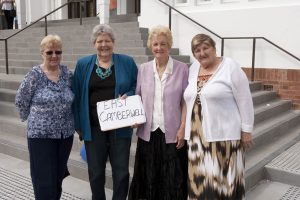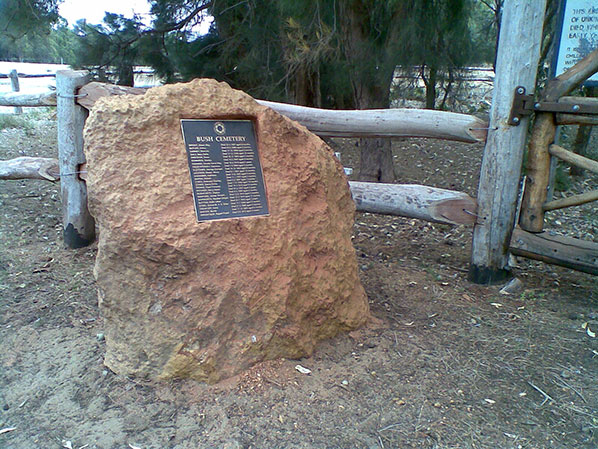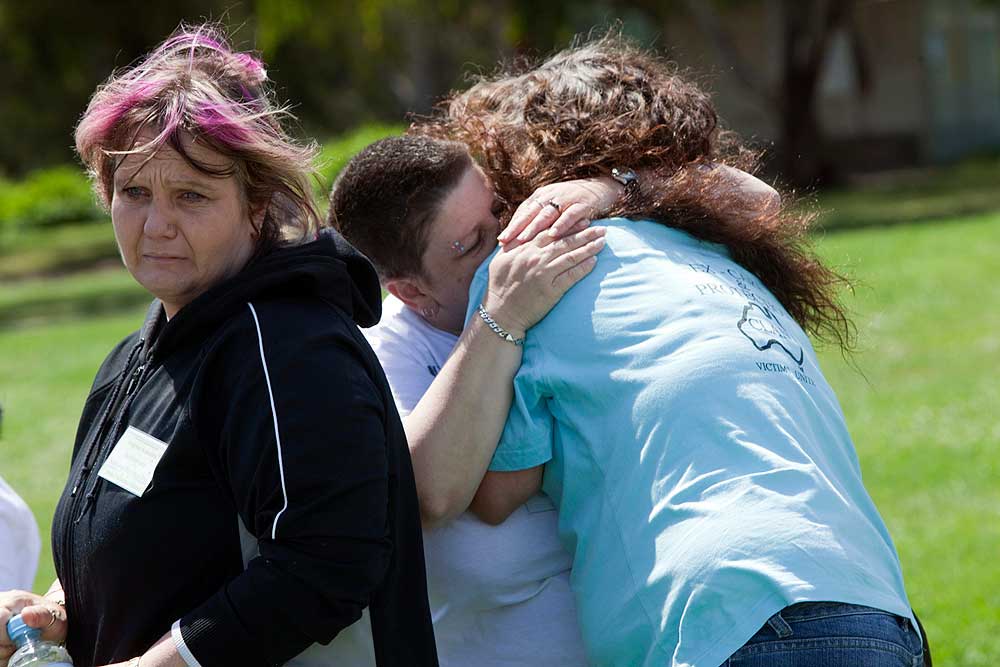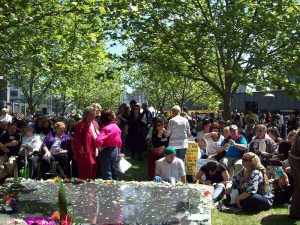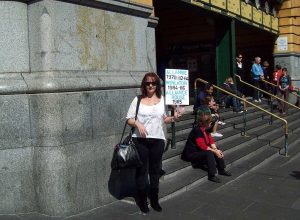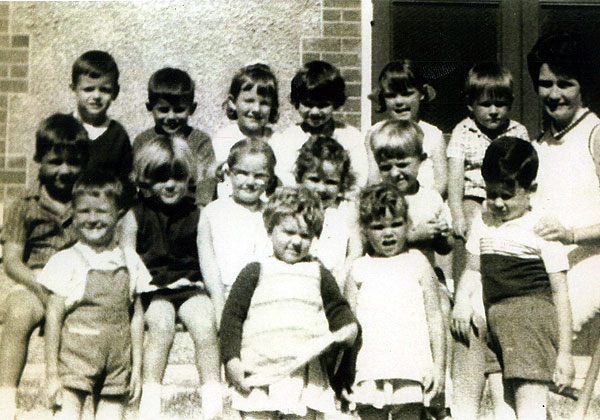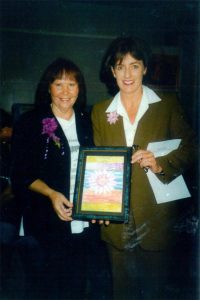by Janice Konstantinidis (guest author) on 28 February, 2011
Janice Konstantinidis, shares a current photograph, as well as her detailed history of her time from the age of 12 working in the laundry of Mount Saint Canice, Tasmania, one of the Magdalena laundries, nicknamed “The Mag”. Janice also includes recollections of the lengths some girls would go to in order to escape.
Mount Saint Canice
At the age of twelve, I was taken by my grandparents and father to Mount Saint Canice, one of the Magdalene Laundries. The laundry was run by the Order of Good Shepherd Nuns in Hobart, Tasmania. There were a number of these laundries in Australia, as well as in other parts of the world. I am not sure how or why it came to pass that women and children were taken in by the nuns, but I know that the courts had no hesitation in sending adolescent girls to these homes for punishment. It was also common for parents to place their children in these homes when they could no longer house them, or for any number of reasons. It is not my purpose to speculate here as to why the state allowed this and, indeed, there has been an inquiry and subsequent public apology to all of us who were incarcerated in this manner. It is important for me to write my own record of my experiences so that it can become public knowledge. In doing so, I hope that no child now or in the future ever has to experience the horror I did.
I had been told that I was going to Mount Carmel, a Catholic boarding school in Hobart. My father had been asked to find a school for me as his parents, who were unwell, were no longer able to care for me. My father was a sadistic alcoholic, and he had lied to my grandmother about where I was going. In her mind, the nuns could do no wrong.
My first day at Mount Saint Canice began at six a.m. It was pitch black and cold. The lights were turned on, hurting my eyes, as a nun came through each dormitory calling out loudly “In the name of the Father, and of the Son, and of the Holy Spirit”. All of the inmates got out of bed and fell to their knees. I was to learn that this command was to be obeyed immediately upon penalty of losing a mark. I will talk about marks later.
I also got out of bed and dropped to my knees. We said the Lord’s Prayer in unison. I was then told by a girl next to me to make my bed, and to get washed and dressed. We lined up at the unlocked door and waited until all were assembled, before filing through the next dormitory and down two flights of stairs. As I type this, I look back and realize that there were no exit signs and no fire escapes in that particular area. Even so, the doors were locked at every turn. We would have been in serious danger had a fire ever broken out.
We walked silently through two more doors, our numbers growing as each group joined us. We eventually ended up in the convent church. We, the girls from the home, had a part for ourselves that had been sectioned off, although some of the older girls sat in the public area. The nuns had their section as well. We had to attend Mass each morning. I was Catholic, so this was not new to me; but many girls were not and, therefore, resented having to attend Mass. I have to say that I resented this as well, as I did not have a strong belief in God.
We were not allowed to speak at all. When Mass was over, we filed back in order, based on who had come from where. Once assembled, we made our way to the refectory for breakfast, which was usually oatmeal with milk, and toast with butter and jam. After breakfast, we filed out of the refectory. I was escorted to a huge room by Judith, who was an auxiliary nun, and told that it was the ironing room. There, I was introduced to Mother Marguerite, who was in charge of this area. I had never seen anything like it. There were ten large cloth-covered ironing tables that ran through the middle of the room. These were duplicated, so there were twenty places at which the girls would iron. There were huge steam pressers and steam egg-like implements used for pressing clothes. These ran along either side of the tables. There was also an area that led to the next room, and just nearby, there were many bins of wet clothes waiting to be ironed.
I was shown to a table near Mother Marguerite, who was ironing. She pulled a bin towards me and informed me that it was my job to iron handkerchiefs until the bell rang, and that I would then be collected for school as I was a school girl. Once again, I was told that there was to be no talking. I was shocked, to say the very least, at this turn of events. I had no idea what was going on, but I began to iron the handkerchiefs obediently. This and other laundry work would be my employment until I left Mount Saint Canice at age 15 and a half.
We were pretty much governed by bells. They would be rung late at night and first thing in the morning for the nuns, the first one being at 6 a.m. These bells became a way of life for me. They also corresponded with my need to perform rituals, so I was able to put a lot of my existing obsessive compulsive disorder into the various bells as they sounded. All nuns immediately stopped whatever they were doing at the sound of the bell; even if they had been in the process of dotting an “i”.
At nine a.m., I was called out by a girl in school uniform. She told me her name, and took me to the area of the convent in which the school-aged girls were given lessons. At that point, I was still of the belief that I would find myself at Mount Carmel. But this was not to be the case.
The school room and general area was divided into three rooms. We used one for the classroom, one for sewing, and the other for cooking. Our teacher was Mother Claver, a small but plump nun with a sharp tongue, whose bark was a bit worse than her bite. I was shown some navy skirts, white blouses, and navy sweaters to see which would fit me. I tried as hard as I could to find the right size, but nothing fitted me very well. I was given some white socks and told that I would get a pair of lace-up shoes when my size came in. I was then taken to the room where the cooking was done. Another nun, Mother Philip, was teaching cookery there, so I joined a girl at a table. I felt uncertain about all this as I knew that I was in the wrong color uniform for girls from Mount Carmel. They wore light brown tunics with sky blue blouses.
As I looked around me, I saw, in the distance, what I thought was a long, blue swimming pool. I asked the girl next to me if we were going to swim in it at some point. She looked at me peculiarly, and asked me to repeat myself. The class was silent and everyone was looking at me. I think there were about 15 of us who were of school age. When I repeated myself, I was told, amidst roars of laughter, that that was no pool, and to go and have a proper look. I walked over to the windows, which were huge and took up one entire side of the building. One girl said to me, “Can you see now?” I could see that what I had thought was a pool was actually blue corrugated iron. She asked me if I could see the rolls of barbed wire on top, and I told her that I could. I could also see that the windows through which I was looking were barred; ornate, but barred nonetheless. Someone asked me where the f****** I thought I was. I told her that I was at the Mount Carmel Boarding school for Catholic girls. Huge peals of laughter followed. I was then informed that I was in the “Mag”. I asked what that was, and was told that it was the Magdalene Girls’ Reformatory – otherwise known as Mount Saint Canice. I then asked why there were bars on the window, and was told they were there to prevent us from jumping out, and that the fence was there to ensure that we would not run away. I could not absorb what they were saying, and I suddenly began to feel unwell; I was having an anxiety attack. Mother Phillip guided me into the next room to sit down. I thought that my heart would break. I felt very betrayed and humiliated, and I began to cry. I told Mother Phillip that there had been a mistake made, and that I had been sent to the wrong school. She told me that I had been placed with them by my family, and that I had to stay. I asked her when I could go home, but she told me that it would be some time before I would be allowed to leave. It turned out that it would be eight months before I was allowed a break for Christmas. I can’t describe the turmoil engulfing my mind at that point. The reality was simply too sad for me to contemplate.
My memories of my early days at Mount Saint Canice are not consistently vivid, although I am not sure why. I recall that the first night was exceedingly frightening for me. Due to my extreme anxiety, my face was going numb quite a lot. I had been given a seat at a table with three other people in the refectory – which, by the way, was a new word for me. There were about 200 girls inside. The first thing that I noticed was that they were not all young, and I was puzzled by this. The refectory was divided into three areas, one of which had women who were quite old. It turned out that some of these were the women who ran the convent farm; some were intellectually challenged; and some had been in the convent for most of their lives. I would learn all about this later.
I felt quite uncomfortable as I sat in the dining room. I felt as though everyone was looking at me, and I suppose they were. After all, I was the new girl. I was seated at a table with Judith, the auxiliary nun mentoned abive. These women wore grey habits with grey stockings and black lace-up shoes. They also wore veils with a light blue strip of fabric around the head area, although it was not a full-faced coif like those worn by the other nuns. They also wore light blue and grey belts, and had large silver crucifixes hanging from their necks. These nuns took yearly vows and were usually the product of a lifetime in the institution. While not considered for ‘proper’ orders, they were nonetheless nuns as they saw it; and some, like Judith, were in charge of a group of girls.
Mealtime was unusual. In the afternoon, we had bread with butter and jam, along with cups of tea. Sitting at my table was a young woman who was about 18 to 20 years old. She was profoundly intellectually challenged, and she carried her teddy bear with her at all times. Judith cared for her; in fact, she was like her child. Her name was Kerrie Anne. She could not speak, and was very myopic. I was frightened of her at first because Judith told me that she bit people if she was annoyed.
There was no speaking allowed while eating. I later learned that one could speak if it was the feast day of a saint. Whenever she came into room, the nun on refectory duty would say “God be blessed”, and the room would buzz with chatter. When we finished eating, we washed our cutlery in colored plastic bowls which were bought to the table by the girls whose turn it was to do so. The bowls were filled with hot, soapy water from a large jug, which was also brought to the table. We reset the places, wiped our placemats with a cloth, and dried the cutlery with a tea towel. Our plates were taken away when we were finished. We all took turns at these jobs.
After tea that first afternoon, I went to what was known as a group room. I was allocated to a group called the Rosarians. There were about thirty girls to a group, and we had four groups. The nun in charge of my group was Mother Magdalene. The group room was used for recreation, and had chairs and tables for crafts and puzzles. We also had a TV and various other bits and pieces. We took turns to clean the group room.
On my first night in the dormitory, I recall being very frightened. I had been allocated a bed in a huge room which was shared by about 40 girls. All the women at the home were referred to as girls, regardless of age. I was not able to sleep in the two rooms that the other group members used as they were short of a bed for me; so I slept in the dormitory used by some of the older girls and auxiliary nuns. My bed was in the centre of the room in the middle of a line of beds. I recall the main lights going out as it was my turn to shower. It would have been nine o’clock. My shyness about going to the shower made me late. I was also extremely nervous and I dropped my new shampoo and watched helplessly as it spilled all over the tiles. The bottle, which had the name Blue Clinic on it, was made of glass. I was so upset that I had spilled it. Thankfully someone came to help me to clean it up. I also recall going to bed with wet hair that night. I could still see the moon through the windows. I noticed that these windows were also barred, but I tried not to pay too much attention to this. I cried that night; it was all very, very strange to me. I was also particularly upset because I could not perform my rituals in case I was seen, so I had to do them in my mind. I had developed OCD when I was nine years old and I hade developed a need to perform many rituals as a result of this. My time in Mount Saint Canice made all this considerably worse, as I was constantly anxious.
The curriculum at the school at Mount Saint Canice could have been worse. It covered basic arithmetic, spelling, and the usual subjects up to about grade four level. I recall being annoyed that we had to learn about Burke and Wills. I tended to do my work and say very little. After some weeks, Mother Claver asked me to help some other girls, and I did this throughout the rest of the school year. I was very sad about this, as I knew that I was not learning and the thing that had been so very important to me since I began school, was to absorb myself in my school work. Most of the girls found their schoolwork to be very hard. There was one other girl of my age who was unable to manage her schoolwork. I will refer to her as Lucy, although this is not her real name. Lucy and I became friends and have remained in contact to this day. She had been placed in the home because her parents were heavy drinkers and her mother had thrown her into a fire.
I kept hoping that I would be able to go home to tell my grandmother about all that I was experiencing. My watch had been stolen in the first week, as had my underwear. The latter were, however, replaced by Mother Anselm from the reserves that she had. These clothes were new, but were very old-fashioned; they were made of pink cotton, and the bras were unlike any I had ever seen. I later discovered that they had originally been purchased for the nuns. Long pink petticoats and white ankle socks were the norm. Lucy had come to the home as an emergency placement and had no clothes on arrival, so the pink clothing was not new to her.
During my first week at Mount Saint Canice, my neck was burned. All girls had to be deloused and checked for fleas. I was aghast at the very notion, but had no choice but to go along with it. On my second day, I was given a bottle of vile-smelling liquid by Judith, and told to shower with it. I think this was usually done on the first day, but I had arrived late the previous day. Judith also delegated an older girl to wash my hair with kerosene, and this is what burned my neck. There was also no treatment for this.
We all had to take a glass of Epsom salts once a week. This was to ‘clean us out’ and, in fact, usually gave us diarrhea. We all hated drinking it, but we would lose a mark if we refused. There was also no sense trying to write home about our circumstances, as all our mail was read. This applied to both incoming and outgoing mail. Some girls had to rewrite their letters, while others found pieces cut out of the mail that they received from home and friends. We were allowed to read and write letters on Saturday afternoons in our group rooms, and all letters had to be shown to the group nun.
School ended with a bell at 3 p.m. We filed out in line to the refectory. After having our afternoon tea, we went back to work in our respective places in the laundry until 5 p.m. when we finished work. We were allowed back into the dormitory to have a quick wash before having dinner at 5.30 p.m. As usual, there was no talking, except when we were given permission to do so. The meals, while fattening, were generously proportioned and always warm. I have to give credit here; no one went hungry.
There was even a convent cat to feed. My grandfather had been in the habit of drowning my cats whenever they had kittens. I would come home to find my cat gone and sometimes only one kitten left. I grew to like the convent cat. It belonged to Mother Phillip and I used to amuse Lucy by writing poems about it.
The laundry was huge. There was the ironing room where I worked when I was not in school, the machine room where Lucy worked, the folding and packing room, and the drying rooms. The machine room was very large and contained two enormous mangles and rows of large washing machines. These machines were operated by one man who had been employed by the convent for years. He was unfortunate enough to have his daughter come to the home a year or so later. He was not allowed to speak to her, but they would look at each other from a distance.
The laundry provided services to hospitals and many other institutions. It also offered private laundry services, mainly to the priests, as well as to the archbishop’s residence. To my knowledge, it was the biggest commercial laundry in southern Tasmania. The mangles, which pressed all flat items, were so large that it took two girls to feed a wet sheet into one, and two on the other side to remove and fold it. The heat was so intense that a wet sheet would only need to be fed through once. The work that we did in the ironing room was different, and consisted of tending to smaller items such as underwear, shirts, and hankies. There were dozens of shirts and hundreds of hankies per day. This work was done every weekday from 8 a.m. to 5 p.m., and girls who were aged over 14 worked on Saturday mornings as well.
I was allocated a place in a new dormitory in time for my 13th birthday. I recall being glad that I could finally see out of a window. Our dormitory was three storeys high, and although my window had bars, I could see the moon and some of lower Sandy Bay, and for this I was immensely grateful. There were nine beds in the room, which was one of the smaller dormitories, and Judith and Kerrie Anne were my roommates. I had a bed, a single locker, a chair, and a mat. Our beds had to be made to army standards, and we had to keep our area clean and tidy. There was an inspection every Saturday afternoon, after which we were given our marks.
Sometimes the girls would try to escape. In fact, on occasion they were successful. But they were invariably caught by the police and brought back to the home. Their hair would be cut roughly within an inch of their scalps, and their fingernails would undergo similarly harsh treatment. “Punishment frocks”, which were dresses made from hessian with bias binding trim, would also be worn for some months. The girls could wear a skivvy under them, but all of their own clothes, with the exception of socks and underwear, were confiscated. These punishment frocks had to be worn to “parlor,” much to the humiliation of the girls. Parlor was the room in which the girls saw their family on the second and fourth Sunday of the month. Some girls who were nearing the end of their sentence would be allowed home for a weekend. This was an extremely special event. In all my time at Mount Saint Canice, I never went to parlor. I had no visitors, with the exception of one visit from relatives from the country who had heard that I was at the home.
There is one particular incident that I will never forget. A group of three girls was planning to escape one Sunday night while the rest of the girls were watching a film. I was in my dormitory helping to bathe Kerrie Anne when they attempted to escape. I had gone to the window to see if I could see them jump. They had planned to jump from the third floor bathroom window – this was one of the few windows that had no bars – to a ledge, to another ledge, and then to the roof of the first floor, which was concrete and had been added on to the home in its later years. The first girl jumped, but lost her footing when attempting to land on the ledge. She kept falling until she landed on the concrete roof. I heard her fall and saw that she lay still. The alarm was sounded by someone and the flood lights came on. An ambulance and the police were called. We soon learnt that the girl had broken her back. We never saw her again. We were told that after being discharged from the hospital, she was sent to Lachlan Park, which was a mental institution. We were all very upset by this. I felt awful because I had known that they were intending to escape, and I repeatedly wondered if perhaps I should have informed one of the nuns. Then again, to do so would have led to a physical thrashing for me and I was afraid of the bullying that took place in the home.
The other girls who wanted to escape from the home would cut themselves or take some other action that would require admission to hospital, as this was seen as preferable to being at the home. One girl who had escaped, been recaptured, and whose hair had been cut off as a result, was working with me in the ironing room one day. Mother Marguerite had gone out for a few minutes. The girl was working on a press for shirts, and I saw her lay her hands on the press as one would do to flatten out a shirt. I then noticed with horror that she let the press down on her hands. I ran to her, thinking that it must have been a terrible accident, and I stepped on the release foot pedal. But this was a mistake as her hands were stuck to the top lid of the press. She screamed, I screamed, and an older girl raced to help us. The burned girl was taken to the hospital and did not return until sometime later. Despite the trauma that I experienced, I was expected to carry on with my work, and to eat my afternoon tea as if nothing had happened. I had nightmares for a long time about the girl who had jumped, and the girl who had burned herself.
I was terrified of the times that I spent as a carer for three girls who had epilepsy. I was terrified of seizures, but was given the job of watching these girls – some of whom were over 21 years old – at night. We slept in a room with nothing but mattresses so that, in the event of a seizure, no one could do themselves any harm. When a girl had a seizure, I had to run from the room – I was given trustee privileges for this – and I had to pull hard on the rope that rang the bell. Mother Marguerite was the convent nurse and, after a time, she would appear with an injection for the girl or girls, as sometimes another girl would have a seizure as well. I was so horrified that I could hardly speak. I would even have anxiety attacks of which they were completely unaware. To say that I lived my life in constant anxiety and fear while in the convent would be an understatement.
There were times of incredible sadness for some of the girls. Sometimes a girl would come to the home pregnant, or another might escape and become pregnant. Although she would try to hide her condition for as long as possible, she was eventually sent to Elim House in West Hobart, which was a Salvation Army home for unwed mothers. The girls eventually came back to us after they had delivered their babies. Some of them were over 18, but remained wards of the state until they were 21 years old. They, therefore, had no say in what happened to them or their babies. To see their sorrow at having lost their children was heartbreaking. To see them punished for what, in hindsight, seems to have been depression was also devastating. Worst of all was the news that one girl had hanged herself, which was such a shock to me that I felt unable to breathe for some time. She had been a lovely person. She had come to the home in the very early stages of pregnancy and had been sent to Elim. She’d come back to tell us that she’d had a baby boy.
On Saturday mornings, we were allowed to sleep in until 7 a.m. We went to a later Mass, had our breakfast, and came back to the dormitories to clean them. We would even wash and polish the floors on our knees. Everything in the convent was always spotless, and we took turns cleaning the bathrooms, which were then inspected.
We were expected to shower every night and again in the morning if we wanted to. Due to my constant efforts to get the kerosene out of my hair, I began to wash it every day, and I have continued this practice to this day.
We worked in our dormitories until lunch time. After lunch, we went to our group room and we were allowed to talk or play a game until Mother Magdalene came, at which point we had other activities to do. Every second Saturday, Mother Anselm would come to the groups as well. She would be told about us and would give us marks and pocket money according to how many marks we had received. I believe that these marks were a way of maintaining some degree of control over the girls. Three marks were to be given to each girl; one for work/school, one for our general care of ourselves and cleanliness, and the other for our general behavior. If we were ‘good’ in all three areas, we received four shillings. If we lost a mark, it would be three shillings. The loss of two marks meant that we got only two shillings, and the loss of all three marks meant that we received no pocket money and no special privileges such as being allowed to go to the movies, which were shown on Sunday nights.
Other forms of punishment took the form of the extra cleaning of the dormitory floors. Used tea leaves were thrown over the floors, which we would then have to sweep and polish. There was a large, red cement hallway that ran through various areas of the home. Scrubbing this hallway while on my hands and knees was a job that I came to know well. It would take me over two hours, and I was expected to use a toothbrush for the grouted areas. I would be given this punishment for simply asking “why?”, or for taking too long in the toilets. They did not consider the fact that I suffered from constipation and that hurrying was, therefore, impossible for me. Furthermore, the red corridor was cold and draughty most of the time.
We always referred to ourselves as slaves, and, looking back, I can see that we were. All the girls who could work, worked long and hard hours, and the sum of four shillings was an insult to them. I had never had any money and was often away in my fantasy world; so it did not occur to me to be less than grateful for anything that came my way that was not going to hurt me. It is hard for me to look back and adequately explain this, but it is how I felt. We were expected to use this money to buy our own toiletries and other items for our personal use. Some girls had parents who provided for them, while others did not. In any case, the nuns took everything that came into the convent and dispensed it as they thought appropriate. Only sanitary pads were provided and we had to ask Mother Marguerite for these. They were known as a packet of “Bunnies” and we were only allowed one packet per menstrual cycle. My periods were heavy and I suffered chapping due to changing napkins infrequently.
We would go up to the dormitories at 7:30 p.m. each week night and lights were out at 9 p.m. I was always excited to get into my bed. I had the most wonderful fantasy life that anyone could imagine and I could not wait to get lost in it. My fantasies were many and varied, but a common theme involved having a large family.
The population of the home consisted of many different girls. There were older girls — women — who no longer worked in the laundry; they would sit outside in one particular corridor where there was sun, in their own group rooms, or perhaps in bed. Some of these girls had not been outside of the home for many years. I knew one older woman who told me she had not been outside for over twenty years. There was another woman in her late thirties whose job it was to care for these girls. As far as I know, this woman had come to the home in her youth, and had never left. Every so often, one of the older women would die, and we were allowed to visit her bed if we wanted to. This was so we could say goodbye to her before she died. I was also terrified of this.
Other girls were younger and suffered from various forms of developmental delay. These girls would often work on the convent farm, which was huge and very productive. They were often overweight, and smelled of cow manure, as I recall. They did not suffer any nonsense from the younger girls. They would clip our ears as we walked past, or hit out at us. Some of these girls had been in the home for as long as they could recall. There was a family of three girls who lived in the home with their mother. I am not sure how this came to be. Then there were the girls who were sent to the home for various so-called crimes — the fallen, the wretched, and the shamed. I have to say that I can’t recall any bad girls at the home. Rather, as I see it, their behavior was the product of being institutionalized. Of course, I did not know any of this then, and I saw myself as bad, and without worth or entitlement.
I have never really recovered from my years of living in Mount Saint Canice. I lived in fear of being locked up again, and maybe, at some levels, I still do. After leaving the home, I went on to make some extremely poor life choices. I was unhappy for most of my life, suffering from profound depression and anxiety. It was not until I was diagnosed with Complex Post Traumatic Stress Disorder in therapy in my late fifties that I began to think and feel like I could actually control my own life. To this day, I believe that someone should be accountable for the tragic occurrences that I witnessed and underwent at that time. When I recall these incidents, I do not believe that any apology given by the government is of any value at for me.
I enjoy a good quality of life now, but I know many women who suffered the same fate in these homes. These women have not been able to lead happy or productive lives. I can only hope that my story will serve to remind people what can happen when children are not cared for or shown the respect and love that they need.
Janice Konstantinidis (nee Exter)
February, 2011












